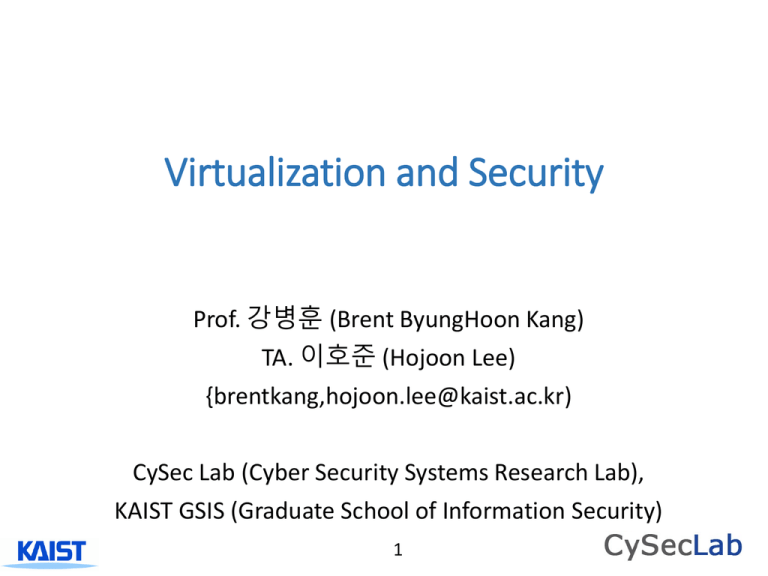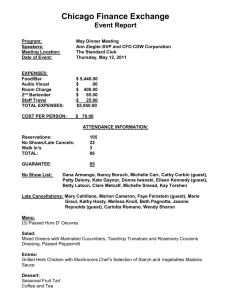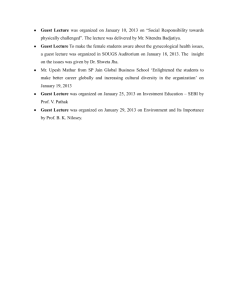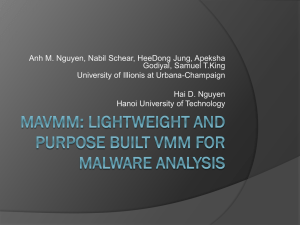Hypervisor - SysSec (System Security) Lab
advertisement

Virtualization and Security
Prof. 강병훈 (Brent ByungHoon Kang)
TA. 이호준 (Hojoon Lee)
{brentkang,hojoon.lee@kaist.ac.kr)
CySec Lab (Cyber Security Systems Research Lab),
KAIST GSIS (Graduate School of Information Security)
1
Content
Hypervisor Internals
CPU Virtualization
Memory Virtualization
Research Trends in Virtualization and Security
Hypervisor Security
Virtual Machine Introspection
Security and Privacy for Cloud
Side Channel Attack Issues
Virtual Machine Introspection (VMI)
Techniques
Demo
2
Virtual Machine Introspection
- Application
• Reduction of Semantic Gap
• Isolation: External Monitor & Scanner
• Flexibility: Building on-demand security functions
Safe from
Rootkit
Security VM
Guest VM
Root
kit
Forwarding Extracted
Semantic
Hypervisor
<Example of VMI application>
Can run
general tools
like…
Ptrace,
Strace,
Netstat…
Trustworthy Cloud Service
• Not only the defense against external threats, but
trustworthy operation is also required…
Security
solutions
are already
available.
Trustworthy
operation
also needs
to be
guaranteed.
고객 데이터
보호-
Trustworthy Cloud Service
Privacy violated
by Google
Employee
Trustworthy Cloud Service Prevention
• De-privileged Control VM
ASIS
Administrator
(remote access)
Gues
t VM
TOBE
Guest
VM
Contr
ol VM
Gues
t VM
Guest
VM
Non Root
mode
Root mode
Control VM
Hypervisor
Access
Control
Hypervisor
TCB : Hypervisor
Trustworthy Cloud Service Detection
•
•
Guarantees Service provider’s legitimate access to guest VM
Audit log collection
o Information flow tracking among Hypervisor ← → Control VM ←
→ GUEST VM
o Log collecting hooks patched on cloud infrastructure
Gues
t VM
- Log collecting hook
injection
- Information Flow
Tracking
- Integrity check
Guest
VM
Control VM
Hypervisor
Isolated env.
Log DB
Audit log Analysis
VM → Admin : Virus Scan,
VMI
Admin → VM : Guest OS
Patch
Hypervisor Internals
CPU Virtualization
8
What is Virtual Machine Monitor
▪ Virtual Machine Monitor = Hypervisor
▪ Software layer to monitor virtual
machines
▪ Resource management
▪ Scheduling virtual machines
▪ Why virtualization?
▪ IBM mainframe in 1960s
▪ Server Consolidation : to use the
remain resource
▪ Isolation from each virtual
machine
9
What is Virtual Machine Monitor
▪ Type 1
▪ Type 2
▪ Run on OS
▪ VirtualBox, KVM, VMware
workstation
▪ Run directly on
hardware
▪ Xen, VMware server
10
What is Virtual Machine Monitor
▪ Xen (Type 1)
▪ KVM (Type 2)
▪ Runs as a part of host kernel
▪ Each VM is a host thread
▪ Run directly on
hardware
▪ Dom0
11
CPU Virtualization
CPU Virtualization
Modern hypervisors use hardware-assisted virtualization
using Intel VT-x (and AMD SVM) technology
We will go through both traditional and HW-assisted
virtualization techniques to understand virtualization
13
CPU Virtualization
The Rings of Privilege
• Privileged Mode (Ring 0)
• Contexts in this mode can execute “privileged instructions”
• Non-privileged Mode (Ring 1 ~ Ring 3)
• Contexts in this mode cannot execute privileged instructions
Operating systems run in privileged mode (ring 0) and user applications run in
non-privileged mode (ring3)
Then WHERE should a hypervisor be placed?
14
Traditional Hypervisor Implementation
• Hypervisor in privileged layer (kernel mode)
• Guest OS in non-privileged layer (user mode)
• As guest OS executes privileged instruction, a trap is generated
and hypervisor emulates the instruction (Trap-and-Emulate)
• Problem: Some privileged instructions do not cause traps, and
performs different operations when executed in Ring0/Ring3
(e.g., POPF)
15
Traditional Hypervisor Implementation
Software-only CPU Virtualization
• Binary Translation (VMware)
•Scan Guest OS code to locate “non-virtualizable”
instructions and substitute with equivalent set of
virtualizable instructions
• Hypercall (Xen)
•Modify Guest OS source code (i.e. Linux)
•Implement Hypercall interface to replace
privileged instructions with explicit request to
hypervisors
Traditional Hypervisor Implementation
Binary Translation
• Un-virtualizable instructions
are replaced with either
• Equivalent set of nonproblematic instructions
• Trap to hypervisors
Traditional Hypervisor Implementation
ParaVirtulization (반가상화)
• Implements virtualization
through OS source code
modification
• Maximize the cooperation
between OS and hypervisor
• Achieves high performance
Traditional Hypervisor Implementation
Paravirt Operation
• Linux provides a unified paravirtualization API called Paravirt Ops
• Hypervisor vendors use Paravirt Ops to implement paravirtualization
features
Traditional Hypervisor Implementation
Linux kernel can be compiled to replace
sensitive operations with paravirt hypercalls
(using compiler directives)
Intel VT-x
Intel VT-x VMX Enables
Hardware-assisted
Virtualization
• Intel Introduced Virtual Machine
eXtension to achieve efficient
virtualization in x86 architecture
• Splits Ring 0 into two modes
• Root mode : Hypervisor mode
• Non-root mode : Guest OS
kernel mode
• Separate execution mode for
hypervisor
• Allows Guest OS kernel to run in
Ring 0
21
Intel VT-x
Intel VT-x : Motivation
• To complement non-virtualizable aspects of x86 architecture
• Enable efficient virtualization in x86 architecture
• Introduction of new privilege mode for hypervisor (Rootmode in Ring 0)
• Deal with non-virtualizable instructions
• Suppress excessive trapping
• Eliminate software elimination and enable virtualization
without Guest OS modifications (paravirt, binary
translation)
• Deprivileging the Guest OS is no longer needed
22
Intel VT-x
Intel VT-x : Motivation
• To complement non-virtualizable aspects of x86 architecture
• Enable efficient virtualization in x86 architecture
• Introduction of new privilege mode for hypervisor (Rootmode in Ring 0)
• Deal with non-virtualizable instructions
• Suppress excessive trapping
• Eliminate software elimination and enable virtualization
without Guest OS modifications (paravirt, binary
translation)
• Deprivileging the Guest OS is no longer needed
23
Hardware-assisted Virtualization
Hardware-assisted
Virtualization
• VMEXIT occurs automatically for
traps that need to be handled by
hypervisor
• Eliminates need for binary
translation or Paravirtualization
(Guest OS modification)
Hardware-assisted Virtualization
• Intel VT-x and AMD SVM add virtualization extensions to intel/amd x86
• Splits privileged layer (ring 0) into Non-root / Root mode
• Generates traps for instructions that require hypervisor interposition
(VMEXIT/VMENTER)
Hardware-assisted Virtualization
VM0
App
VM1
App
...
App
...
Guest OS0
VM Exit
App
App
...
App
Guest OS1
VM Entry
VM Monitor
Physical Host Hardware
• With VMX, sensitive instructions that require hypervisor causes VM Exit
• Hypervisor handles the event and Issues VM Entry to resume Guest VM
Hardware-assisted Virtualization
VMCS : Virtual Machine Control Structure
•Data structure that manages VMX operations
•Store guest OS states and VMX configurations
Hardware-assisted Virtualization
The VMCS consists of six logical groups:
• Guest-state area: Processor state saved into the guest-state
area on VM exits and loaded on VM entries.
• Host-state area: Processor state loaded from the host-state
area on VM exits.
• VM-execution control fields: Fields controlling processor
operation in VMX non-root operation.
• VM-exit control fields: Fields that control VM exits.
• VM-entry control fields: Fields that control VM entries.
• VM-exit information fields: Read-only fields to receive
information on VM exits describing the cause and the
nature of the VM exit.
Virtual Machine Scheduling
In OS kernel
• Processes are scheduled
In Hypervisor
• VCPUs are scheduled
Memory
Virtualization
Three Levels of Address space
Virtual address
Physical address
Machine Address
Three Levels of Address space
Memory virtualization is needed to
Allocate and isolate memory to VMs
Reflect VM address mappings and
permissions to hypervisor’s page tables
Provide access to Machine Memory to
VMs
Shadow Page Table (SPT)
SPT had been the most widely used memory virtualization
method before Intel Extended Page Tables (EPT) / AMD
NPT
Key techniques in SPT
CR3 accesss traps: Guest writes to CR3 (to make context switches)
are trapped to hypervisor and emulated
Guest kernel page table write-protected : guest kernel writes to its
page table trapped and emulated by hypervisor
SPT maps Virtual Address to Machine Address Directly
Shadow Page Table (SPT)
Shadow Page Table (SPT)
Virtual CR3
Guest
Guest
Guest
Page Table
Page Table
Page Table
Shadow
Shadow
Shadow
Page Table
Page Table
Page Table
Real CR3
Shadow Page Table (SPT)
Virtual CR3
Guest
Guest
Guest
Page Table
Page Table
Page Table
Shadow
Shadow
Shadow
Page Table
Page Table
Page Table
Real CR3
Shadow Page Table (SPT)
Virtual CR3
Guest
Guest
Guest
Page Table
Page Table
Page Table
Shadow
Shadow
Shadow
Page Table
Page Table
Page Table
Real CR3
Shadow Page Table (SPT)
Guest
Guest
Guest
Guest
Page Table
Page Table
Page Table
Page Table
Shadow
Shadow
Shadow
Page Table
Page Table
Page Table
Shadow Page Table (SPT)
Virtual CR3
Guest
Guest
Guest
Guest
Page Table
Page Table
Page Table
Page Table
Shadow
Shadow
Shadow
Shadow
Page Table
Page Table
Page Table
Page Table
Real CR3
Optimizing SPT : Lazy
Pull-through
Trap and emulating every guest kernel page table updates
causes too many VM EXITs
VM EXITs are essentially context switches and cause
performance overhead (due to TLB flushing and etc)
Lazy pull-through
Let L1 (leaf page tables a.k.a PTEs in Linux) be out of sync and sync
when page fault actually occurs
Emulate L4, L3 ,L2 each time
40
Optimizing SPT : Lazy Pull-through
Out of Sync
(Lazy PullThrough)
Emulate at
Every
Write
L4
L3
L1
L2
41
Issues with SPT
Positives
Handle page faults in same way as Emulated TLBs
Fast guest context switching
Page Table Consistency
Guest may not need invalidate TLB on writes to off-line page tables
Need to trace writes to shadow page tables to invalidate entries
Memory Bloat
Caching guest page tables takes memory
Need to determine when guest has reused page tables
42
Intel Extended Page Tables (EPT)
Intel EPT adds another page table pointer called “EPT Base
Pointer”
Another layer (Nested) of Page Table Walking
43
Intel Extended Page Tables (EPT)
44
Intel Extended Page Tables (EPT)
EPT Page Table Entry Structure
45
Intel Extended Page Tables (EPT)
TLB filling with two page tables (Guest PGT + EPT)
46
Intel Extended Page Tables (EPT)
Address Translation with Nested Paging (EPT)
Virtual Address
TLB
Machine Address
3
1
2
Guest
2
Page Table
PhysMap
By VMM
47
3
Intel Extended Page Tables (EPT)
Guest and EPT Structure
48
Intel Extended Page Tables (EPT)
Positives
Simplifies monitor design
No need for page protection calculus
Negatives
Guest page table is in physical address space
Need to walk Physical Map multiple times
Need physical to machine mapping to walk guest page table
Need physical to machine mapping for original virtual address
Other Memory Virtualization Hardware Assists
Monitor Mode has its own address space
No need to hide the monitor
49
State of Art VM-based Research
50
Virtual Machine Introspection (VMI)
VM introspection systems
often aim to
Detect or prevent kernellevel malware (i.e. rootkit)
Identify malicious programs
running in VM
Ensure integrity or secrecy of
processes and files
51
Virtual Machine Introspection (VMI)
VMI systems normally have
Introspection VM
Monitored user VM
VM Monitoring mechanisms
52
Disk
Memory
Network
H/W Events
CPU Registers
Virtual Machine Introspection (VMI)
VM introspection systems
often aim to
Detect or prevent kernellevel malware (i.e. rootkit)
Identify malicious programs
running in VM
Ensure integrity or secrecy of
processes and files
VMWare VMSafe API ™
Libvmi (Open source)
53
Out-of-VM Monitoring vs In-VM Monitoring
Guest VM
Secure VM
Guest VM
In-Guest
Component
Secure VM
Monitor
Hypervisor
Hypervisor
Out-of-VM
In-VM
54
Out-of-VM Monitoring vs In-VM Monitoring
Out-of-VM Monitoring
Monitor resides outside of VM
Benefits
Complete isolation provides maximum security
Simpler Design
Drawbacks
Heavy performance overhead due to context switching
Monitoring granularity
In-VM Monitoring
Monitor has agent inside VM
Adapted for various reasons
Protecting In-VM hooks (Lares Oakland ‘08)
Reducing Performance Overhead (SIM CCS ‘09)
Narrowing Semantic Gap by Executing In-VM code (SYRINGE RAID ‘12)
55
Out-of-VM Monitoring Techniques
Event-triggered Monitoring Techniques
56
Out-of-VM Monitoring Techniques (Cont’d)
Event-triggered Monitoring Techniques
VMI Techniques leverage HW-assisted virtualization feature
to implement Event-triggered techniques
VMEXIT: mechanism that forces a process or thread into
hypervisor context triggered by certain events
VMEXIT trigger conditions
execution of sensitive instructions that needs hypervisor
intervention
Sensitive register value modification
Page faults (non-existent or disallowed memory access)
Other faults (i.e. general protection fault …)
57
Out-of-VM Monitoring Techniques (Cont’d)
Event-triggered Monitoring Techniques (Cont’d)
Virtualized Memory
Guest VM Memory are managed by hypervisor
Shadow Page Table
Extended Page Tables
Memory Monitoring
Mark Pages that we want to monitor Non-writable
When Guest attempts to write to the page, a VMEXIT occurs and
hypervisor’s VMEXIT handler is invoked
One can implement inspection functions in VMEXIT handlers
58
Out-of-VM Monitoring Techniques (Cont’d)
Memory Access
For physical memory region
P in Guest VM
There is machine memory
M
Map M as P’ in Monitor
VM’s memory space
Guest VM
Physical Memory
Space
Machine
Memory
Monitor VM
Physical Memory
Space
M
P
P’
Hypervisor
59
In-VM Monitoring
In-VM Monitoring
Monitor has agent inside VM
Adapted for various reasons
Protecting In-VM hooks (Lares Oakland ‘08)
Reducing Performance Overhead (SIM CCS ‘09)
Narrowing Semantic Gap by Executing In-VM code (SYRINGE RAID ‘12)
60
In-VM Monitoring
Lares
Places an In-VM Hook that is protected by Hypervisor
Security augmentation for traditional kernel hooks typically used by
AV software
61
In-VM Monitoring (Con’td)
SYRINGE
Allows out-of-vm monitor to inject a function call request into VM
Execute in-VM kernel code and returns the results back to monitor
Goal: alleviate semantic gap by reusing in-VM kernel code
62
Semantic Gap
Hypervisor’s visibility on monitored VM are limited to
hardware-level abstractions
Register values
CPU events
Physical memory contents
Security policies involve high-level abstractions
Processes
High-level events
Data structures
63
Semantic Gap
Such discrepancies in level of information creates Semantic
Gap
VMI development requires reconstruction of low-level data
into high-level data structures.
64
Bridging Semantic Gap
Virtuoso
Automatically generates introspection programs based on dynamic
learning from trusted VM
65
Hypervisor-based Dynamic Analysis
FireEye Dynamic Threat Intelligence Cloud™
66
Hypervisor-based Dynamic Analysis
Ether (CCS 2008)
Monitor
The instructions executed by a guest process
Memory writes a guest process performs
System calls a guest process makes
Analysis
Coarse-grained tracing
System calls
Fine-grained tracing
Memory writes and the instructions
67
Hypervisor-based Dynamic Analysis
Guarantee the occurrence of a debug exception after every
instruction by setting a flag called the trap flag
Upon handling a debug exception, Ether will once again set
the trap flag for the next instruction, thereby inducing a
debug exception after every instruction.
Preventing from detecting Ether’s presence
68
Hypervisor-based Dynamic Analysis
Hiding the Trap Flag
PUSHF, INT
If a program set the trap flag?
Be detected by POPF instruction
<Setting trap flag>
Page Table Modifications
SYSENTER_EIP_MSR
Save any value the target attempts to write into
SYSENTER_EIP_MSR
69
Security and Privacy For Cloud
• Guest Kernel Compromised
• Hypervisor is trusted
• Need to protect user applications
app.1
...........................................
......
GuestOS
Hypervisor
Hardware
70
app.N
NetWork
Security and Privacy For Cloud
InkTag
Use 2 EPTs to separate trusted and untrusted page tables
Compromised OS is forced to use Untrusted EPT
Only expose Encrypted application memory
Hypervisor allows Trusted Application to use Trusted EPT
Can read/write to its own memory
Trusted EPT
Untrusted EPT
71
Security and Privacy For Cloud
InkTag
Paraverification – audit kernel response in system call handling
HAP
mmap(file=… ,token=4
0x7fcb
MMU_REGISTER
Guest OS
pte_update(addr =0x7fcb
pte_update(addr…
token=4
Hypervisor
72
Security and Privacy For Cloud
TCB - Nested Virtualization
Threat Model
•
•
app.1
Encrypted
Guest OS
Compromised Hypervisor
Abnormal access to guest VM
......
..
app.6
app.12
......
..
Encrypted
Guest OS
app.N
Data Exfiltration
Control
VM
Hypervisor
Nested
Hypervisor
Interposed security operations
- I/O Verification
- Memory Mapping Verification/Protection
- CPU values Hiding/Protection
Hardware
Control flow
(Guest OS → Hypervisor)
Control flow
(Hypervisor → Guest OS)
Intel TPM/TXT
73
Integrity check
Hypervisor for Security
Hypervisor itself is a software and can also a target of
software attacks
Xen 0wning Trilogy showed possible hypervisor subversion
via DMA
74
Q&A




